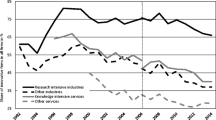Abstract
This paper develops a complementary theory of path dependence based on rigidity resulting from the choice of management system within the firm. Rules-following behavior introduces rigidity which can lead to inefficient path dependence within a firm. Entrepreneurial alertness, in a crisis, can prevent lock-in from occurring since it leads people to alter perceptions and change behavior. An empirical look at the automobile industry explores the idea of rules-following behavior inducing path dependence development and the potential for change despite inefficient path dependent behavior.
Similar content being viewed by others
References
Allinson, G. (1975) Japanese Urbanism: Industry and Politics in Kariya. Berkeley: University of California Press.
Aoki, M. and Dore, R. (Eds.) (1994) The Japanese Firm: Sources of Competitive Strength. New York: Oxford University Press.
Arthur, W. B. (1995) Increasing Returns and Path Dependence in the Economy. Ann Arbor: University of Michigan Press.
Buchanan, J. M. and Tullock, G. (1962) The Calculus of Consent. Michigan: Michigan University Press.
Chandler, A. (1964) Giant Enterprise: Ford, General Motors, and The Automobile Industry. New York: Harcounrt Brace.
Chang, C. S. (1981) The Japanese Auto Industry and The U.S. Market. New York: Praeger Publishers.
Cowen, R. and Gunby, P. (1996) “Sprayed to Death: Path Dependence, Lock-In and Pest Control Strategies.” Economic Journal, XV: 521–542.
Cusumano, M. (1985) The Japanese Automobile Industry. Cambridge: Harvard University Press.
Cusumano, M. (1998) “Manufacturing Innovation: Lessons from the Japanese Auto Industry.” Sloan Management Review, Fall: 29–39.
David, P. (2000) The Meaning of Path Dependence. Economic History Web site discussion paper.
Farrell, J. and Saloner, G. (1985) “Standardization, Compatibility, and Innovation.” Rand Journal of Economics, 16(1): 70–83.
Flink, J. (1988) The Automobile Age. Cambridge: MIT Press.
Fruin, W. (1992) The Japanese Enterprise System. New York: Oxford University Press.
Goodstein, E. (1995) “The Economic Roots of Environmental Decline Property Rights or Path Dependence?” Journal of Economic Issues, XXIX(4): 1029–1043.
Halberstam, D. (1987) The Reckoning. London: Bloomsbury.
Hayek, F. A. (1973) Law, Legislation and Liberty. Chicago: University of Chicago Press.
Heiner, R. (1983) “Origins of Predictable Behavior.” American Econonic Review, 73(4): 560–586.
Ingrassia, P. and White, J. (1994) Comeback: The Fall and Rise of the American Automobile Industry. New York: Simon & Schuster.
Imai, M. (1986) Kaizen: The Key to Japan's Competitive Success. New York: McGraw-Hill Publishing Company.
Katz, H. (1985) Shifting Gears: Changing Labor Relations in the U.S. Automobile Industry. Cambridge: MIT Press.
Kirzner, I. (1973) Competition and Entrepreneurship. Chicago: University of Chicago Press.
Krafcik, J. (1988) “Triumph of Lean Production.” Sloan Management Review. Fall: 41-52.
Liebowitz, S. J. and Margolis, S. (1990) “The Fable of the Keys.” Journal of Law and Economics, XXXIII: 1–25.
Liebowitz, S. J. and Margolis, S. (1995) “Path Dependence, Lock-In and History.” Journal of Law, Economics and Organization, 11(1): 205–226.
Liebowitz, S. J. and Margolis, S. (1994) “Network Externality: An Uncommon Tragedy.” Journal of Economic Perspectives, 8(2): 133–150.
Magnusson, L. and Ottosson, J. (Eds.) (1997) Evolutionary Economics and Path Dependence. Brookfield Vermont: Edward Elgar Publishing Co.
Monden, Y. (1992) Cost Management in the New Manufacturing Age: Innovation in the Japanese Automobile Industry. Cambridge: Productivity Press.
Monden, Y. (1981) “Adaptable Kanban System Helps Toyota Maintain Just-In-Time Production.” Industrial Engineering, XXII: 29–46.
Nelson, R. and Winter, S. (1982) An Evolutionary Theory of Economic Change. Cambridge: Harvard University Press.
Ohno, T. (1988) Toyota Production System: Beyond Large-Scale Production. Cambridge: Productivity Press.
Perrucci, R. (1994) Japanese Auto Transplants in the Heartland: Corporatism and Community. New York: Walter de Gruyter.
Petersen, D. E. (1991) A Better Idea: Redefining the Way Americans Work. Boston: Houghton-Mifflin.
Piore, M. and Sabel, C. (1984) The Second Industrial Divide. New York: Basic Books.
Rae, J. (1984) The American Automobile Industry. Boston: G.K. Hall & Company.
Shingo, S. (1989) A Study of the Toyota Production System. Cambridge: Productivity Press.
Shook, R. (1988) Honda: An American Success Story. New York: Prentice Hall 1988.
Sloan, A. (1964) My Years with General Motors. New York: Doubleday & Company.
Starkey, K. and McKinlay, A. (1993) Strategy and the Human Resource: Ford and the Search for Competitive Advantage. Cambridge: Blackwell Business.
Tolliday, S. and Zeitlin, J. (Eds). (1987) The Automobile Industry and its Workers: Between Fordism and Flexibility. New York: St. Martin's Press.
Vanberg, V. (1992) “Organizations as Constitutional Systems.” Constitutional Political Economy, 3(2): 223–253.
Williamson, O. “Transaction-Cost Economics: The Governance of Contract Relations.” Journal of Law and Economics, 233–261.
Womack, J., Jones, D., and Roos, D. (1990) The Machine that Changed the World. New York: Rawson Associates.
Author information
Authors and Affiliations
Rights and permissions
About this article
Cite this article
Heffernan, G.M. Path Dependence, Behavioral Rules, and the Role of Entrepreneurship in Economic Change: The Case of the Automobile Industry. The Review of Austrian Economics 16, 45–62 (2003). https://doi.org/10.1023/A:1022905224020
Issue Date:
DOI: https://doi.org/10.1023/A:1022905224020




